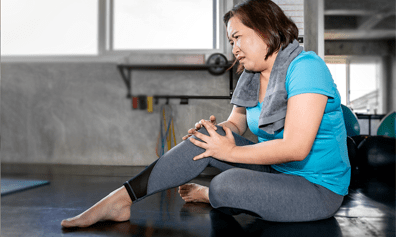
The iliotibial band rubbing against the lateral side of the knee joint during a long-distance run or uphill/downhill run its inflammation leading to the Iliotibial Band Friction Syndrome (ITBFS). It is an overuse injury that occurs over time and is commonly seen in athletes and military personnel.
How do you identify ITBFS?
You will have the following issues if you are suffering from ITBFS:
- Pain on the lateral (outer) side of the knee that worsens with running or activities that cause increased knee bending and straightening
- Swelling and redness on the lateral side of the knee
- Pain in the initial 30 degrees of knee bending
What are the predisposing factors that might put you at risk of ITBFS?
The following factors or activity patterns increase the risk of ITBFS:
- Poor control and balance of the foot
- Use of improper or worn-out footwear unsuitable for the activity being carried out
- Weak core, hip, or leg muscles
- Leg length discrepancy leading to faulty body mechanics during activities
- Inadequate warm-up and cool-down techniques accompanying activities
- Poor running techniques, especially the one that involves inward rolling of the knee
- A sudden increase in training intensity
- Runners, especially the ones who undergo a lot of uphill and downhill running.
- Running on hard surfaces.
- Marathoners and cyclists who undergo long hours of training and activities
- Hiking or rowing for prolonged periods
Managing ITBFS
ITBFS has a good prognosis for both conservative and surgical management. Most of the cases get resolved with conservative management, which would be the first line of action. Surgery is used as a last resort in resistant cases.
The following pointers would help get relief from ITBFS, and following them religiously would help avoid recurrence in the future:
- Rest - Give the tissues time to heal. Then, after taking a sufficient break from activities that caused the issue, start exercises gradually.
- Icing - The painful knee can be iced every hour till the initial pain subsides. The icing can be continued 2-3 times per day.
- Pain Control - Transcutaneous Electrical Nerve Stimulation (TENS) is a good modality for pain relief in people with ITBFS.
- Massage Therapy - Myofascial relaxation technique has been seen to be helpful in cases with ITBFS.
- Stretching - IT band, hamstrings, gluteal muscles, and hip adductors stretching can provide relief. In addition, foam roller exercise also provides a good stretch to these muscles.
- Strengthening - Hip abductor strengthening is also beneficial.
Getting back on track after ITBFS
The following points would help safely return to physical activities while reducing the risk of future recurrence:
- Modification of training protocol: Overtraining should be avoided. The training should be gradually increased in intensity.
- Avoid the factors that increase the risk of ITBFS, like uphill or downhill running.
- Wear appropriate footwear with proper arch support.
- Avoid running on hard surfaces as much as possible.
ITBFS does not have to be a life sentence. However, understanding the risk factors and modifying them play a key role in ensuring a healthy and safe ITBFS-free life!
































































